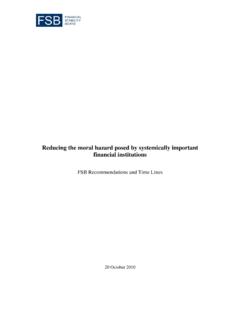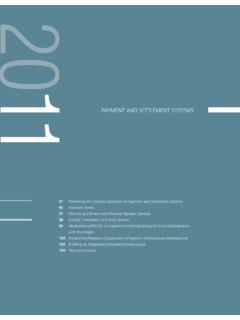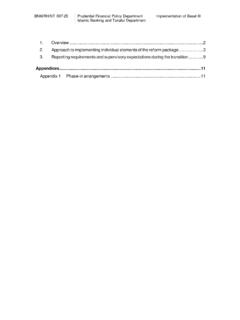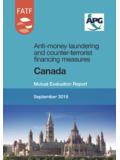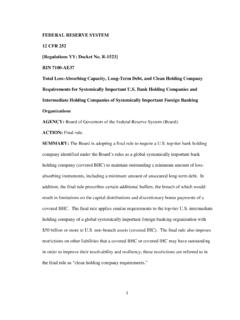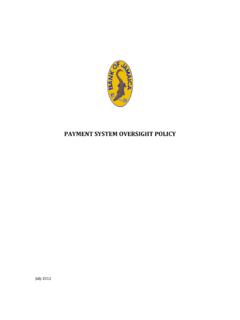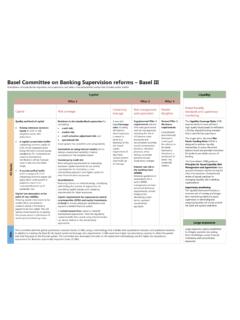Transcription of Executive Summary EXECUTIVE SUMMARY - FATF-GAFI.ORG
1 Anti-money laundering and counter-terrorist financing measures in Canada - 2016 FATF and APG 2016 3 EXECUTIVE SUMMARY EXECUTIVE SUMMARY This report provides a SUMMARY of the anti-money laundering and combating the financing of terrorism (AML/CFT) measures in place in Canada as at the date of the on-site visit (3-20 November 2015). It analyses the level of compliance with the FATF 40 Recommendations and the level of effectiveness of Canada s AML/CFT system, and provides recommendations on how the system could be strengthened. Key Findings 1. The Canadian authorities have a good understanding of most of Canada s money laundering and terrorist financing (ML/TF) risks. The 2015 Assessment of Inherent Risks of Money Laundering and Terrorist Financing in Canada (the NRA) is of good quality. AML/CFT cooperation and coordination are generally good at the policy and operational levels.
2 2. All high-risk areas are covered by AML/CFT measures, except legal counsels, legal firms and Quebec notaries. This constitutes a significant loophole in Canada s AML/CFT framework. 3. Financial intelligence and other relevant information are accessed by Canada s financial intelligence unit, FINTRAC, to some extent and by law enforcement agencies (LEAs) to a greater extent but through a much lengthier process. They are used to some extent to investigate predicate crimes and TF activities, and, to a much more limited extent, to pursue ML. 4. FINTRAC receives a wide range of information, which it uses adequately, but some factors, in particular the fact that it is not authorized to request additional information from any reporting entity (RE), limit the scope and depth of the analysis that it is authorized to conduct. 5. Law enforcement results are not commensurate with the ML risk and asset recovery is low.
3 6. Canada accords priority to pursing TF activities. TF-related targeted financial sanctions (TFS) are adequately implemented by financial institutions (FIs) but not by designated non-financial business and professions (DNFBPs). Charities ( registered NPOs) are monitored on a risk basis. 7. Canada s Iran and Democratic People s Republic of Korea (DPRK) sanction regime is comprehensive, and some success has been achieved in freezing funds of designated individuals, there is no mechanism to monitor compliance with proliferation financing (PF)- related TFS. 4 Anti-money laundering and counter-terrorist financing measures in Canada - 2016 FATF and APG 2016 EXECUTIVE SUMMARY 8. FIs, including the six domestic systemically important banks, have a good understanding of their risks and obligations, and generally apply adequate mitigating measures. The same is not true for DNFBPs.
4 REs have gradually increased their reporting of suspicious transactions, but reporting by DNFBPs other than casinos is very low. 9. FIs and DNFBPs are generally subject to appropriate risk-sensitive AML/CFT supervision, but supervision of the real estate and dealers in precious metals and stones (DPMS) sectors is not entirely commensurate to the risks in those sectors. A range of supervisory tools are used effectively especially in the financial sector. There is some duplication of effort between FINTRAC and the Office of the Superintendent of Financial Institutions (OSFI) in the supervisory coverage of federally regulated financial institutions (FRFIs) and a need to coordinate resources and expertise more effectively. 10. Legal persons and arrangements are at a high risk of misuse, and that risk is not mitigated. 11. Canada generally provides useful mutual legal assistance and extradition.
5 The authorities solicit other countries assistance to fight TF and, to a somewhat lesser extent, ML. Informal cooperation is generally effective and frequently used. Risks and General Situation 12. Canada has a strong framework to fight ML and TF, which relies on a comprehensive set of laws and regulations, as well as a range of competent authorities. 13. It faces an important domestic and foreign ML threat, and lower TF threat. As acknowledged in the public version of the authorities 2015 assessment of Canada s inherent ML and TF risks (the NRA), the main domestic sources of proceeds of crime (POC) are fraud, corruption and bribery, counterfeiting and piracy, illicit drug trafficking, tobacco smuggling and trafficking, as well as (to a slightly higher level than assess) tax evasion. Canada s open and stable economy and accessible financial system also make it vulnerable to significant foreign ML threats, especially originating from the neighbouring United States of America (US), but also from other jurisdictions.
6 The main channels to launder the POC appear to be the financial institutions (FIs), in particular the six domestic systemically important banks (D-SIBs) due to their size and exposure, as well as money service businesses (MSBs). While not insignificant, the TF threat to Canada appears lower than the ML threat. A number of TF methods have been used in Canada and have involved both financial and material support to terrorism, including the payment of travel expenses of individuals and the procurement of goods. Overall Level of Effectiveness and Technical Compliance 14. Since its 2007 evaluation, Canada has made significant progress in bringing its AML/CFT legal and institutional framework in line with the standard, but the fact that AML/CFT obligations are inoperative for legal counsels, legal firms and Quebec notaries is a significant concern.
7 In terms of effectiveness, Canada achieves substantial results with respect to five of the Immediate Outcomes (IO), moderate results with respect to five IOs, and low results with respect to one IO. Anti-money laundering and counter-terrorist financing measures in Canada - 2016 FATF and APG 2016 5 EXECUTIVE SUMMARY Assessment of Risks, coordination and policy setting (Chapter 2 - ; , , ) 15. The authorities have a generally good level of understanding of Canada s main ML/TF risks. The public version of the 2015 NRA is of good quality. It is based on dependable evidence and sound judgment, and supported by a convincing rationale. In many respects, the NRA confirmed the authorities overall understanding of the sectors, activities, services and products exposed to ML/TF risk. While the NRA s findings did not contain major unexpected revelations, the process was useful in clarifying the magnitude of the threat, in particular the threat affecting the real estate sector and emanating from third-party money launderers.
8 The authorities nevertheless may be underestimating the magnitude of some key risks, such as the risk emanating from tax crimes and foreign corruption. 16. All high-risk areas are covered by the AML/CFT regime, with the notable exception of the legal professions other than British Columbia (BC) notaries, which is a significant loophole in Canada s AML/CFT framework, and online casinos, open loop prepaid cards, and white label ATMs. 17. While supervisory measures are generally in line with the main ML/TF risks, more intensive supervisory measures should be applied in some higher risk areas such as the real estate and DPMS. 18. AML/CFT cooperation and coordination appear effective at the policy level, but in some provinces, greater dialogue between LEAs and the Public Prosecution Service of Canada (PPSC) would prove useful.
9 19. While FIs generally appear adequately aware of their ML/TF risks, the same does not apply in some DNFBP sectors, in particular the real estate sector. Financial Intelligence, Money Laundering and Confiscation (Chapter 3 - IOs 6-8; , , ) 20. Financial intelligence and other relevant information is collected and used to some extent only by competent authorities to carry out investigations into the predicate crimes and TF activities, and, to a more limited extent, to pursue ML. FINTRAC receives a range of information from REs and LEAs, which it adequately analyses. Some factors nevertheless hamper its ability to produce more comprehensive intelligence products, in particular, the fact that FINTRAC is not authorized to obtain from any RE additional information related to suspicions of ML/TF. FINTRAC s analysis and disclosures are mainly prepared in response to the requests made by LEAs in Voluntary Information Records (VIRs).
10 LEAs use these disclosures mainly to investigate the predicate offense, rather than to carry out ML investigations. FINTRAC also produces strategic reports that address the LEAs operational priorities and advise them on new ML/TF trends and typologies. Information resulting from cross-border transportation of cash and other bearer negotiable instruments is not exploited to its full extent. The FIU and the LEAs cooperate effectively and exchange information and financial intelligence on a regular basis and in a secure way. 21. LEAs have adequate powers and cooperation mechanisms to undertake large and complex financial investigations. This has notably resulted in some high-profile successes in neutralizing ML 6 Anti-money laundering and counter-terrorist financing measures in Canada - 2016 FATF and APG 2016 EXECUTIVE SUMMARY networks and syndicates.










